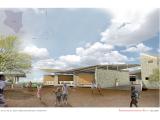
CRPL 472/872
Natural hazards, such as severe winter storms, flooding, and tornadoes play a major role in how cities develop and plan. It is because of their natural and inevitable occurrence that there is very little we can do to control them; and all communities are vulnerable to a list of natural and man-made hazards, especially that of flooding and severe storms. The hazards listed in these attached student plans have the potential to threaten the safety of residents, to damage or destroy both public and private property, to cause environmental degradation, and to disrupt the local economy and overall quality of life.
Mitigation planning is defined as having the potential to produce long-term and recurring benefits by breaking the repetitive cycle of disaster associated loss, as defined by these communities. It is largely assumed that investment in mitigation strategies will greatly reduce the demand for post-disaster assistance (i.e. emergency response, repair, recovery, and reconstruction). However, the benefits of mitigation planning go beyond reducing hazard vulnerability. See how these mitigation plans compare and differ. Is your community prepared?
Follow the College of Architecture





